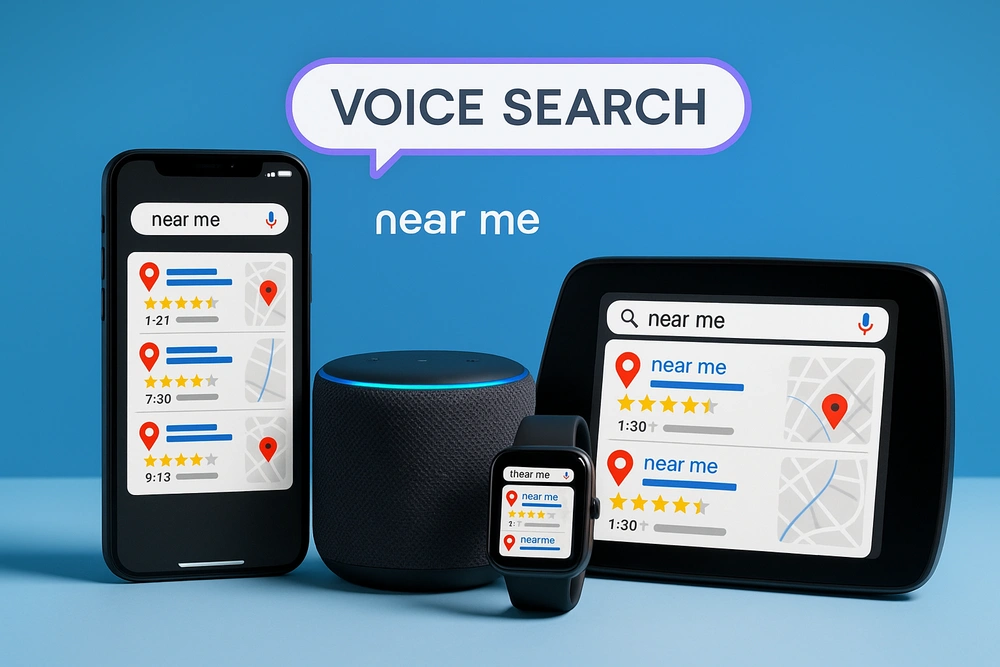Voice Search SEO: Complete Optimisation Guide. The way people search online has fundamentally changed. Instead of typing keywords, users now speak naturally to devices, asking complete questions and expecting instant answers. Voice Search SEO has evolved from an optional enhancement to an essential strategy, with over 8.4 billion voice-enabled devices worldwide and 1 billion monthly voice searches transforming how businesses must approach digital visibility.
Understanding and implementing Voice Search SEO optimisation determines whether your business appears when potential customers ask their devices for recommendations, directions, or solutions. The businesses mastering voice optimisation today capture tomorrow’s traffic while competitors remain invisible to voice searchers. seo and voice search seo strategy
What is Voice Search SEO
Voice Search SEO is the practice of optimising website content and technical elements to rank for voice-activated searches performed through devices like smartphones, smart speakers, and voice assistants, including Siri, Alexa, Google Assistant, and Cortana. Unlike traditional text searches using short keywords, voice queries mirror natural conversation patterns with complete sentences and questions.
When someone types a search, they might enter “best coffee in Dubai.” Voice search transforms this into “What’s the best coffee shop near me right now?” This fundamental difference requires completely different optimisation approaches. Traditional SEO tactics alone won’t capture voice search traffic.
Why Voice Search SEO Matters for Business Growth
The statistics reveal voice search’s explosive growth and business impact. By 2025, 75% of U.S. households will own smart speakers, while 27% of mobile users will regularly use voice search. More significantly, voice commerce drives $82 billion in annual sales, growing 322% since 2021 and projected to reach 30% of total e-commerce by 2030.
Voice searches demonstrate high commercial intent. People asking “Where can I buy…” or “Which company offers…” are ready to act immediately. Voice searchers convert faster because they’re often on-the-go, hands-free, and seeking immediate solutions. Missing voice search means missing ready-to-buy customers actively seeking your products or services.
Local businesses particularly benefit from voice optimisation since 75% of voice searches have “near me” intent, and 72% of voice-enabled speaker owners use them to find local businesses. For service providers, restaurants, retail stores, and professional services, Voice Search SEO directly drives foot traffic and phone calls.
Optimise for Conversational Keywords
Voice queries use natural language, requiring different keyword strategies. Focus on long-tail conversational phrases matching how people actually speak rather than type. Instead of targeting “dentist Dubai,” optimise for “Who is the best dentist near me?” or “Where can I find an emergency dentist open now?”
Question-based keywords dominate voice search. Structure content around who, what, where, when, why, and how questions your customers ask. Research shows nearly 20% of voice queries are triggered from just 25 question words and descriptive terms like “best,” “how,” and “what.”
Create content answering specific questions directly and concisely. Voice assistants prefer clear, straightforward answers, typically 29 words or fewer. Structure pages to immediately address the question in the first paragraph before providing additional details.
Master Featured Snippets and Position Zero
Voice assistants frequently pull answers from featured snippets—the highlighted answer boxes appearing above organic search results. Earning featured snippet positions dramatically increases voice search visibility since devices often read these snippets as voice search answers.
Format content for snippet optimisation using clear headers, bulleted lists, numbered steps, and concise paragraphs. Answer questions directly within the first 40-50 words. Use proper heading hierarchy with H2 and H3 tags, structuring information logically for both users and search engines.
Tables and formatted lists perform exceptionally well for featured snippets. When explaining processes, comparisons, or data, structure information in easily scannable formats that search engines can extract and present as answers.
Implement Local Voice Search SEO
Local optimisation proves critical for Voice Search SEO success. Ensure your Google Business Profile contains complete, accurate information, including business name, address, phone number, hours, categories, and detailed descriptions. Upload high-quality photos regularly and respond to all reviews promptly.
Maintain NAP (Name, Address, Phone) consistency across all online directories and citations. Inconsistent information confuses voice assistants and hurts rankings. Include location-specific keywords naturally throughout website content, particularly in titles, headers, and meta descriptions.
Create location-specific content addressing local customer needs. Include neighbourhood names, local landmarks, and area-specific services in your content. Voice searchers often include location modifiers, making geographic relevance essential for visibility.
 Optimise Technical Elements for Voice
Optimise Technical Elements for Voice
Technical optimisation ensures voice assistants can access and understand your content. Implement schema markup providing structured data about your business, products, services, and content. FAQ schema, Local Business schema, and How-To schema particularly benefit Voice Search Guidelines visibility.
Mobile optimisation is non-negotiable since most voice searches occur on smartphones. Ensure fast loading speeds under three seconds, a mobile-responsive design, and easy navigation on small screens. Voice searchers expect immediate results, making speed critical for rankings and user experience.
Secure your site with HTTPS, as voice assistants prioritise secure websites. Create XML sitemaps, helping search engines discover and index content efficiently. Use clean URL structures with descriptive, keyword-rich paths rather than random character strings.
Create FAQ Pages and Conversational Content
Dedicated FAQ pages perfectly align with voice search behaviour. Compile common customer questions and provide clear, concise answers. Structure each question as an H2 or H3 heading followed by a direct answer in 2-3 sentences, then additional detail if needed.
Write content conversationally using natural language patterns. Read the content aloud to test whether it sounds natural when spoken. Avoid overly formal or technical language unless your audience expects it. Voice search favours content matching how people actually talk.
Include conversational phrases and natural transitions between topics. Use contractions, ask rhetorical questions, and employ a second-person perspective addressing readers as “you.” This conversational approach improves both voice search performance and user engagement.
Track Voice Search Performance
Monitor voice search traffic separately from traditional organic search. Google Search Console provides insights into question-based queries driving traffic. Analyse which conversational keywords generate visits and optimise for similar patterns.
Track featured snippet wins showing when your content appears in position zero. Monitor local pack appearances for location-based searches. Use call tracking to measure phone calls from voice searches, which is particularly valuable for local businesses.
Test your voice search presence directly. Use various voice assistants to search for your services, products, and brand. Check whether your business appears in the results and how competitors rank. Regular testing reveals optimisation opportunities.
Your Voice Search SEO Action Plan
Voice Search SEO optimisation requires systematic implementation. Start by auditing existing content for conversational opportunities, then optimise high-traffic pages with question-based keywords and direct answers. Build FAQ sections addressing customer questions comprehensively.
Mastering Voice Search
Moz Local SEO Guide: Focus on local optimisation, ensuring accurate, consistent business information across all platforms. Implement schema markup providing structured data for voice assistants. Monitor performance regularly and refine strategies based on results.
Voice search continues growing exponentially, reshaping how customers discover businesses. Companies optimising for voice today position themselves for sustained visibility and growth while competitors struggle to catch up in an increasingly voice-first digital landscape.


 Optimise Technical Elements for Voice
Optimise Technical Elements for Voice